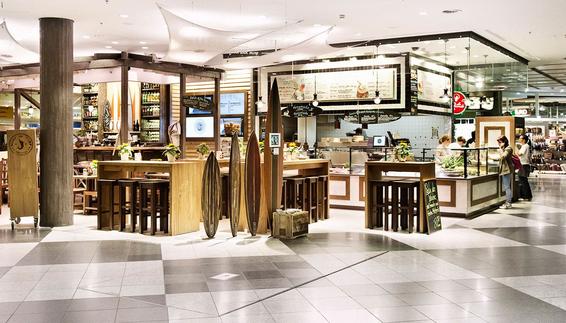December 13, 2018
Munich Airport and Lufthansa are working together to make air travel sustainable and have made a public commitment to the goal of effectively limiting environmental and climate effects. In the new "Green Gate" exhibition in the airport's satellite terminal, passengers can now learn about the many-faceted programs and initiatives of the two companies to promote sustainable mobility.
In the Gate K21 waiting area in the satellite terminal, the partners have created a discovery zone with an appealing visual concept, centered around fascinating aspects of environmental and climate protection. Information panels with short texts, images, infographics, videos and interactive elements offer an easy-to-understand look at the measures already taken to improve the ecological balance as well as the future strategies. With its sustainable design and state-of-the-art climate buffer, the satellite terminal itself sets new standards for energy efficiency. The Green Gate presentation also highlights Lufthansa's achievements in fuel efficiency, especially with its modern fleet. The prime example is the Airbus A350-900, one of the world's most innovative passenger aircraft, which Lufthansa operates on its long-haul routes from the Munich hub.
"The airport and the airline complement one another and are working to capture synergy effects. This makes Munich Airport a leader in green aviation. Here you can see one of the world's most advanced long-haul jetliners parked at one of the world's best terminals. That not only creates greater comfort for passengers. It benefits the environment, too," said Dr. Michael Kerkloh, the CEO and President of Munich Airport at the official opening of the Green Gate. Wilken Bormann, the CEO of Lufthansa's Munich Hub, noted the shared climate protection strategy of the aviation industry, which calls for a 1.5 percent annual improvement in fuel efficiency through to 2020 and a 50 percent reduction in net CO2 emissions by 2050 as compared with 2005 levels. "The Airbus A350-900 achieves better fuel economy than any comparable aircraft, and uses an average of just 2.9 liters of fuel per 100 passenger kilometers. In addition, the new "whisper jet" significantly reduces the noise impact on residents in the surrounding area. The noise footprint of the A350 is 50% smaller than that of the A340," said Mr. Bormann.
The Green Gate displays offer insights into a multi-faceted range of topics related to sustainability in aviation. For example, there are information panels on new approach procedures, the environmentally friendly procedure for supplying aircraft with pre-conditioned air, aircraft de-icing and the recycling of de-icing fluids, air quality monitoring, and the commitment of the two companies to biodiversity and noise/sound protection. Visitors can hop onto an LED stepper to generate electric power through their own efforts or use a CO2 calculator to measure their personal carbon footprint.
With Green Gate, Munich Airport and Lufthansa are highlighting their shared commitment to sustainable and responsible operations in all spheres of activity in order to boost ecological efficiency, both in the airport itself and in flight operations.










